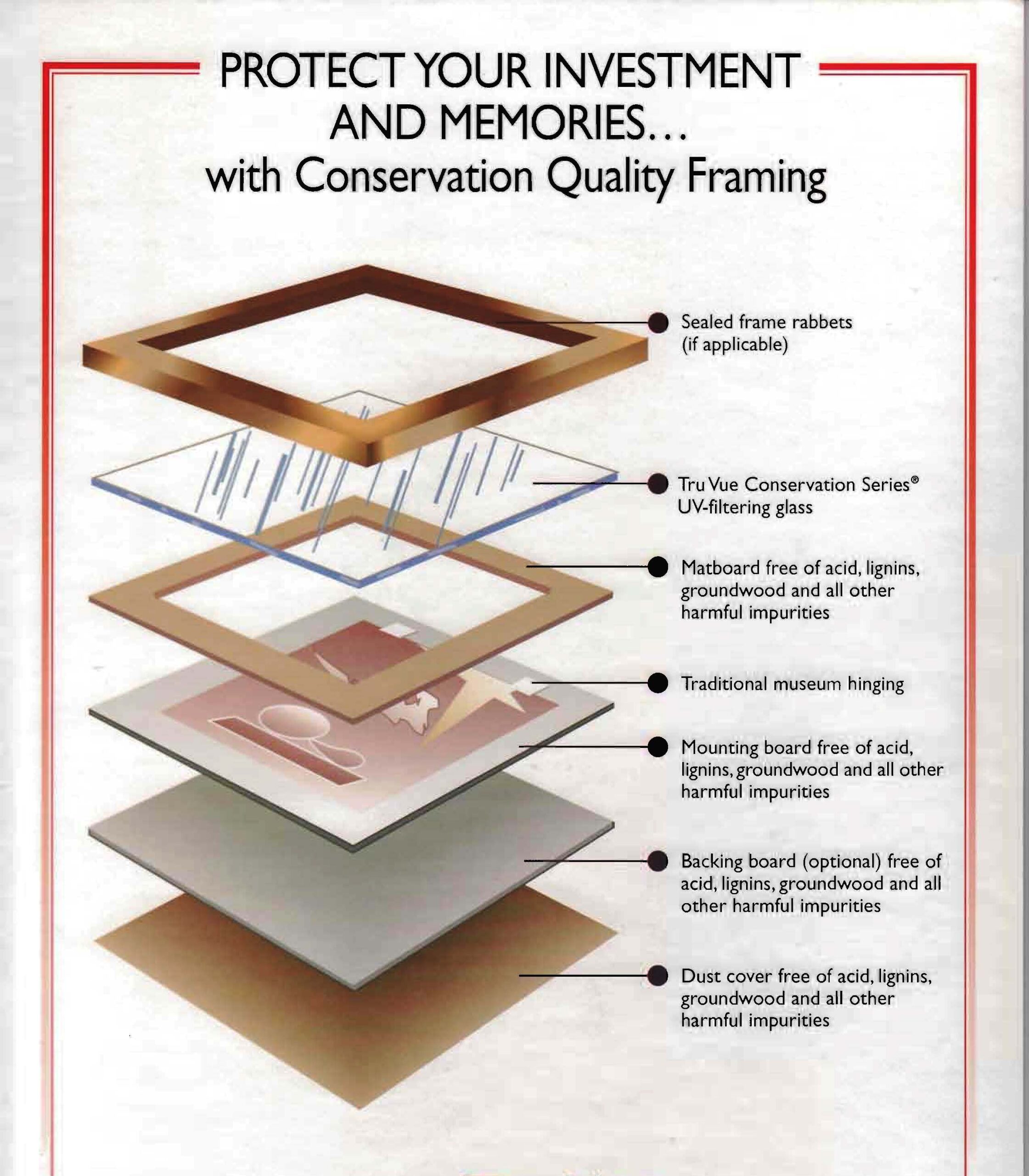Artwork Frames & Framing Education

What is Conservation Artwork Framing?
To best protect and display a work of fine art, modern conservation techniques in artwork framing can keep it safe from damage, and beautiful year after year. The materials and design used in framing should enhance the beauty of the work while protecting and preserving the integrity and value of the piece. Sadly, careless framing can put artwork at risk of irreversible damage.
Framing art professionally with museum-quality materials intended to extend the life of a work of art is referred to as ‘Conservation Artwork Framing’. The materials for this kind of work come in many types and levels of quality. Yet, only some are designed to protect and preserve the artwork for its lifetime. Making sure the materials you choose for framing are of art conservation quality is crucial when handling any piece that has significant value.
What Protections Do Paper Works of Art Need?
Artwork done on paper is highly susceptible to damage and environmental factors. The fibers in paper expand and contract with changes in temperature, humidity, and light. As such, they can be severely affected by exposure to factors like these and more. Paper reacts and interacts especially easily when it comes in contact with certain chemicals. These include the acids that are used in the production of cellulose-based paper, boards, and mats.
We have all seen brittle, crumbling antique photographs and artwork that have been severely yellowed, or browned (acid burns). Some might have developed dark spots (called foxing) or faded from exposure to damaging UV rays. These are all common types of paper damage that quality framing is intended to prevent. This happens when the materials and methods used meet the level of ‘Conservation Artwork Framing’. Regrettably, the damage is often permanent, and restoration comes at a high cost.
How to Frame Art Professionally
If your artwork has already suffered damage from past exposures, consult a conservator. He or she can advise you on your options for restoration, if possible. Often, the best course of action may be to leave the piece as is. To prevent further damage, move forward and consider protecting it through museum-quality conservation artwork framing. A master framer at the FrameStore can help you. Before you bring the artwork in for framing, make sure to complete any restoration work that you plan to attempt.
It is essential to avoid certain practices that can lead to further damage to your art that may greatly reduce its value when considering how to frame art professionally.
- It is strongly advised that you refrain from cutting, trimming, or folding any artwork. Personal inscriptions, notations, margin marks, or any kind of alteration can reduce the value of the artwork. It is worth remembering that a work of art exists as it was intended by the artist. Any alteration to a piece can cause a loss of value.
- Avoid the use of any tapes or adhesives that are not specifically designed for conservation-level mounting of fine art. Masking tape, Scotch tape, etc. will likely damage the work, and should never be used in artwork framing.

What to Avoid in the Art of Framing
Certain types of artwork framing and certain framing methods can leave your artwork open to potentially costly damage or environmental degradation that can reduce the value of your works. To frame art as professionally as possible, avoid these framing methods:
Metal art frames, contrary to popular belief, rarely have reliable conservation qualities. Strictly speaking, these should be avoided with any valuable artwork. Unlike wooden frames, metal artwork frames don’t allow the same kinds of sealing for joints and backing. This exposes your artwork to damaging environmental factors such as moisture, air, bugs, dirt, and others. To protect valuable artwork, it is important to seal it from exposure to such environmental elements.
Mass-produced factory-made art frames, a.k.a Ready-Made Frames rarely ever use true conservation-level materials. As a result, they are very likely to damage your artwork. Matting, backing boards, and mounts are most often made from non-rag paper that actually ends up burning your artwork and photographs, and damages the fibers of the paper due to the acids that they contain. Furthermore, many factory-made frames do not use UV protective glazing, leaving your art open to permanent fading caused by light exposure.
Frames that are too small for the size of your artwork will not hold the weight of the art, mats, mounts, and glass over time. They will eventually fail, leading to possible direct damage or exposure to environmental factors. The frame you use for your fine art must be heavy and sturdy enough to bear the weight of the entire design over the life of the framing. A foundational part of framing artwork professionally is selecting a frame of the correct size and dimensions, while structural integrity is a key factor in protecting your artwork in the long run.
Artwork framing that does not use mats or spacers to separate your artwork from the glazing opens your fine art to severe damage. Condensation can form on the inside of the glass in the framing design. Mats, made of fabric or acid-free rag paper, are designed to separate and put a space between your artwork and the glazing. This space is a key factor in protecting your artwork against humidity and condensation damage. If you do not wish to use a mat in your framing for design and aesthetic reasons, you can use special spacers in the rebate of the frame to lift the glazing away from the artwork.

Read more about conservation, professional artwork framing, and methods at the links below. Also, be sure to check out our pages on design and art theory for more help on how to custom-frame your fine works of art!
- Conservation Glazing for Fine Art
- Museum Quality Conservation Mounting
- The Elements of Art
- Color Theory and Design
For more information on conserving and protecting your fine art, visit our Artwork Framing FAQ section. You can see some of the most commonly asked questions about how to custom frame art. You can also talk to an art and design expert at any of our seven southern California custom-framing stores.